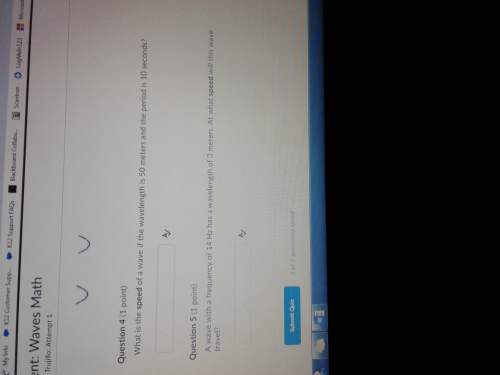
Consider the example of a positive charge q moving in the negative z-direction with speed v with the local magnetic field of magnitude B in the z-direction.
Find F, the magnitude of the magnetic force acting on the particle. Express your answer in terms of v, q, B, and other quantities given in the problem statement.

Answers: 2
Another question on Physics

Physics, 22.06.2019 14:10
Your starship, the aimless wanderer, lands on the mysterious planet mongo. as chief scientist-engineer, you make the following measurements: a 2.50-kg stone thrown upward from the ground at 14.0 m/s returns to the ground in 5.70 s ; the circumference of mongo at the equator is 2.20×10^5 km ; and there is no appreciable atmosphere on mongo. (a) the starship commander, captain confusion, asks for the following information: what is the mass of mongo? (b) if the aimless wanderer goes into a circular orbit 2.20×10^4 km above the surface of mongo, how many hours will it take the ship to complete one orbit? (c) an unmanned spacecraft is in a circular orbit around the moon, observing the lunar surface from an altitude of 44.0 km . to the dismay of scientists on earth, an electrical fault causes an on-board thruster to fire, decreasing the speed of the spacecraft by 23.0 m/s . if nothing is done to correct its orbit, with what speed (in km/h) will the spacecraft crash into the lunar surface?
Answers: 1

Physics, 22.06.2019 17:00
In the future, people will only enjoy one sport: electrodisc. in this sport, you gain points when you cause metallic discs hovering on a field to exchange charge. you are an electrodisc player playing the popular four disc variant. the disks have charges of qa = −8.0 µc, qb = −2.0 µc, qc = +5.0 µc, and qd = +12.0 µc. (1) you bring two disks together and then separate them. you measure the resulting charge of these two disks and find that it is +5.0 µc per disk. which two disks did you bring together? (a) a and b (b) a and c (c)a and d (d)b and c(e) b and d (f) c and d. (2) you bring three disks together and then separate them. you measure the resulting charge of these three disks and find that it is +3.0 µc per disk. which three disks did you bring together? a, b, and c (a) a, b, and d (c) a, c, and d (d) b, c, and d. (3) given the resulting charge of each disk measured in (b) is +3.0 µc, how many electrons would you need to add to a disk of this charge to electrically neutralize it? electrons
Answers: 3

Physics, 22.06.2019 18:10
A200-n force is applied to the foot-operated air pump. the return spring s exerts a 2.6-n·m moment on member oba for this position. determine the corresponding compression force c in the cylinder bd. if the diameter of the piston in the cylinder is 40 mm, estimate the air pressure generated for these conditions. state any assumptions. enter a positive number for the compression force c.
Answers: 2

Physics, 23.06.2019 01:00
What is the frequency if a wave that pases a given pount 22 times in 2 seconds
Answers: 1
You know the right answer?
Consider the example of a positive charge q moving in the negative z-direction with speed v with the...
Questions

Mathematics, 23.02.2021 02:10

Mathematics, 23.02.2021 02:10


Mathematics, 23.02.2021 02:10




Mathematics, 23.02.2021 02:10


Mathematics, 23.02.2021 02:10




Chemistry, 23.02.2021 02:10


Social Studies, 23.02.2021 02:10

Mathematics, 23.02.2021 02:10


Mathematics, 23.02.2021 02:10

Spanish, 23.02.2021 02:10




